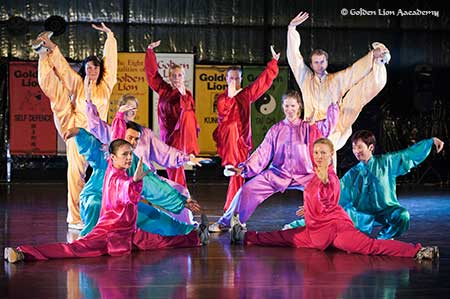In this section on tai chi movements, we’ll also be covering various topics such as positions and exercises for both beginners and advanced level students.
Tai Chi is a gentle mind-body healing exercise that is performed in a tranquil, graceful way to keep the mind and body fit. It is purposely practised in a slow, continuous and controlled way. This removes the impact on your joints, stimulates deep relaxation, improves concentration, balance and coordination, and removes stress.
The “dream like” pace of these ancient exercises enhances the alpha waves of the brain, which allows you to gain the benefits of meditation in motion. Unlike other exercise programmes, the gentle low impact nature of this therapeutic mind-body exercise system is suitable for all age groups and allows us to continue training as we age.
The Golden Lion programme helps you to promote the normal circulation of blood, fluids and Chi life force energy throughout your body. According to Traditional Chinese medicine, when the circulation of these vital substances become blocked or impaired, disease can result. When taught and performed correctly Chi and blood flow is enhanced, resistance to illness increased and a greater feeling of wellbeing is experienced.
The first thing you must learn about tai chi movements
One of the hardest lessons to learn when studying tai chi as a fitness for health exercise or as a martial art, is to do less.
I don’t mean practice less: no, almost certainly we could all do more of that.
I’m talking about the way we move. To be more powerful, with greater control, we need to do less.
Before you think I’m completely deranged, just think about it. You all watch and study your instructors’ moves. They seem to have such strong, sweeping poses, their arms and legs in constant motion. It is like watching the waves on the beach, pushing forward and drawing back. Unceasing. Uncompromising. Every action carrying great intent.
You try to emulate their tai chi movements. Your arms are all a-swinging, your legs they are a-kicking. But somehow, despite your most determined efforts, you lack the same effortless force your instructor demonstrates. Almost certainly their graceful balance eludes you, too. You are closer to splashing in the bath than the unbridled force of nature that is the ocean.
The secret?
You are doing too much!
Power in tai chi movements
Power doesn’t come from your arms. The arms are merely the endpoint for all the energy. They provide control – whether you are punching, blocking or deflecting, high or low – but not the power.
So swinging your arms in huge arcs and hurling your shoulder into every punch is putting the energy into the wrong place. It wears you out and serves little purpose other than to throw you off-balance.
Do less with your arms. More is definitely less in this case.
However there is a time and place where more is more. The power has to come from somewhere. If it’s not the arms, then where is it?
The waist.
It is the waist that westerners need to use more. We are conditioned by our living habits to hardly ever use our waist: computers, cars and televisions all train us to sit with our head over our chest, chest over our legs, all centred and facing forwards.
Our heads don’t move, our waist doesn’t move and our weight remains equally spread on left and right sides. This posture is stable, certainly, but it’s a long way from generating any kind of power.
If you are a car-lover will recognise the term ‘torque’. The power in a car is measured by its engine speed and its torque. Torque is basically a unit of turning force. It is in rotation that energy is most efficiently generated. So too with humans!
In tai chi, turning your waist is where your force comes from. The speed at which you throw a punch is secondary to ensuring you get the waist turning correctly first, otherwise you’re wasting energy by trying to make up with speed what you lack in power.
Once you have your waist turning more, your arm automatically needs to move less: it is moved around by the rest of your body, just like those beaded swinging drums made famous in Karate Kid. When it comes to your waist, more is more.
So next time you’re practicing, or studying the movements of your instructor, think about where more is less… and where more is more!
Our Blog contains more articles on tai chi moves and techniques.
For more details on tai chi classes, please call 9796-1066 today, or contact us here.

